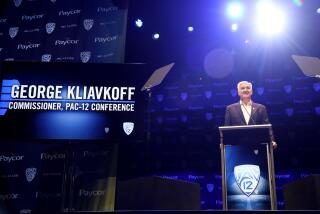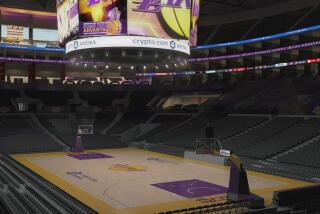Exchange’s Big Move Excites Pacific Officials : New Trading Floor First Part of Expansion Plans
- Share via
Thanks in part to the hot stock market these days, trading volume has been booming for Doug Collett and other floor brokers at the Pacific Stock Exchange in downtown Los Angeles.
But with overcrowded conditions on the exchange’s 54-year-old trading floor at 618 S. Spring St., many firms don’t have the space to add more floor brokers to handle the increased volume.
“This floor is functionally obsolete,” says Collett, who works for New York-based INC Trading. “We’re doing the best we can, but it’s just not as smooth.”
Collett’s complaints may soon be over. On Jan. 13, the Pacific will move to a new, $5-million state-of-the-art trading floor in the Beaudry Center II building on Beaudry Avenue and 3rd Street just west of the Harbor Freeway.
The move to the new floor, nearly double the size of the old one, has been eagerly awaited for years by brokers and others dissatisfied with the Spring Street address. That had been the center of the Los Angeles financial district until the early 1970s, when many firms moved to the redeveloped Bunker Hill area in downtown Los Angeles and conditions began to deteriorate.
The move also comes as the Pacific finds itself in an intensifying competitive battle with other equity, options and futures exchanges in Chicago and New York.
The New York Stock Exchange and the Midwest Stock Exchange are increasingly trying to cut into the small-share trading business that the Pacific has specialized in, thanks to its sophisticated, state-of-the art computers designed for efficient handling of trades of 1,000 shares or less. The average trade on the Pacific is about 400 shares, far lower than the average on the NYSE or Midwest.
Meanwhile, the Pacific has found it difficult to convince giant Wall Street brokerage houses, investment bankers and institutions such as pension funds to shift more of their large-share block trades to the West Coast from the Big Board.
It has also been largely frozen out of trading in several hot new securities products, including options on such market indexes as Standard & Poor’s 500 composite index or the NYSE composite index. It had hoped to get a piece of that action by merging with the NYSE, but merger talks were aborted last year. (The Pacific’s options trading floor is in San Francisco along with a second equity trading floor.)
But Pacific officials say the new floor will be the foundation of a marketing and sales push to boost its market share and image in the U.S. financial community.
“The new floor is a platform for our future growth,” says Charles E. Rickershauser, the exchange’s chairman and chief executive of six years who is leaving those posts March 31 to join a private law firm.
“It’s a better psychological selling point,” says James S. Gallagher, Pacific’s president and chief operating officer. He says he doesn’t invite many trading chiefs from brokerage firms and institutions to visit the Spring Street location, fearing that they would be turned off by its antiquated floor and poor neighborhood.
But with the new facility, he says, “we’d like them to see it because New York now looks terrible by comparison.”
Gallagher also says the extra space will allow firms to place more brokers or specialists on the exchange, in turn boosting trading volume. The Pacific plans to add six new specialists posts on Jan. 27, part of an expansion that has seen the number of specialist posts at its San Francisco and Los Angeles floors grow to 71 from 51 in January, 1985. Specialists execute stock trades and are responsible for maintaining an orderly market.
The new facility also could be used to house a futures trading operation, which would be the first on the West Coast. The Pacific filed with the Commodity Futures Trading Commission in November for permission to trade futures, although exchange officials have not yet decided what contracts they would offer if approval is granted sometime this year, Gallagher says.
The new facility also will allow the exchange to consolidate its trading, data processing, clearing and depository operations in one building. The exchange’s central computer operations now are several blocks away from the Spring Street floor.
Gallagher dismisses critics who say the Pacific will have trouble competing with the big Eastern and Midwestern exchanges. The Pacific, he says, has more than doubled its annual trading volume, to an estimated 1.36 billion shares in 1985 (about 5.7 million shares daily) from 567.6 million in 1981. That makes it the third-largest stock exchange after the NYSE and American Stock Exchange in overall volume but the second largest after the Big Board in total number of trades.
Competing Well
The NYSE is now trying to boost its computer capabilities to capture a greater share of Pacific’s small-trade business, Gallagher says.
“They think we’re competing very well with them,” he says, noting that one Big Board official recently asked him, “‘What are you guys doing taking all these trades from us?”’
Gallagher’s five-year goal, which he describes as “realistic,” is to double the Pacific’s market share to between 7% to 8% of the NYSE’s total volume. Gallagher also wants to boost the Pacific’s percentage of total trades to 15% of NYSE trades from 10% now.
Pacific floor traders generally share Gallagher’s optimism.
The move “is going to put us on the map,” says Richard Lee Goforth, a floor broker with Crowell, Weedon & Co. who has been trading at the Pacific for 22 years. He contends that the new floor is going to help major brokerages “see that we’re a more viable market.”
“It’s going to help us attract new talent,” says Edward R. Cox, a floor broker for Seidler Amdec Securities and a member of the Pacific’s board of directors.
Not Going to Be Easy
But convincing others to direct more business to the Pacific is not going to be easy.
“If brokers find the Pacific better for handling block trades, then it might see more volume,” says Robert Arnott, chief investment officer for Los Angeles-based Trust Services of America, which manages $3 billion in pension and trust assets. But now, the firm’s brokers direct between 90% and 95% of its trading to the Big Board, he says. “I wouldn’t anticipate any significant shift in our use.”
“My guess is it wouldn’t have any effect one way or the other,” says the head of the Los Angeles office of a major brokerage firm, who asked not to be identified. But, he adds, “We don’t care where the exchange is . . . we just try to get the best trades for our clients.”
More to Read
Inside the business of entertainment
The Wide Shot brings you news, analysis and insights on everything from streaming wars to production — and what it all means for the future.
You may occasionally receive promotional content from the Los Angeles Times.










